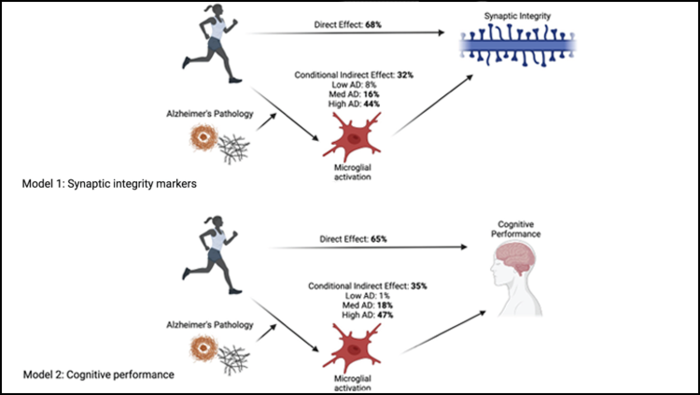No one will disagree that an active lifestyle is good for you, but it remains unclear how physical activity improves brain health, particularly in Alzheimer’s disease. The benefits may come about through decreased immune cell activation, according to new research published in JNeurosci.

Credit: Casaletto et al., JNeurosci 2021
No one will disagree that an active lifestyle is good for you, but it remains unclear how physical activity improves brain health, particularly in Alzheimer’s disease. The benefits may come about through decreased immune cell activation, according to new research published in JNeurosci.
Microglia, the brain’s resident immune cells, activate to clear debris and foreign invaders from the brain. But too much activation can trigger inflammation, damage neurons, and disrupt brain signaling. Exercise helps reduce aberrant activation in animals, but that link hadn’t been established in humans.
Casaletto et al. examined the relationship between physical activity and microglia activation in 167 older adults across the spectrum of cognitive aging (majority nondemented) as part of the Rush Memory and Aging Project. The participants wore activity monitors 24 hours a day for up to ten days straight before annual cognitive exams. The researchers measured microglia activation and Alzheimer’s disease (AD) pathology in postmortem brain tissue analyses. Greater physical activity was linked to lower microglial activation, particularly in the inferior temporal gyrus, a brain region hit the hardest by AD. Physical activity had a more pronounced effect on inflammation in people with more severe AD pathology. Future research will examine if physical activity interventions can alter microglia activation in AD patients.
###
Paper title: Microglial Correlates of Late Life Physical Activity: Relationship With Synaptic and Cognitive Aging in Older Adults
Please contact [email protected] for the full-text PDF and to join SfN’s journals media list.
About JNeurosci
JNeurosci, the Society for Neuroscience’s first journal, was launched in 1981 as a means to communicate the findings of the highest quality neuroscience research to the growing field. Today, the journal remains committed to publishing cutting-edge neuroscience that will have an immediate and lasting scientific impact, while responding to authors’ changing publishing needs, representing breadth of the field and diversity in authorship.
About The Society for Neuroscience
The Society for Neuroscience is the world’s largest organization of scientists and physicians devoted to understanding the brain and nervous system. The nonprofit organization, founded in 1969, now has nearly 37,000 members in more than 90 countries and over 130 chapters worldwide.
Journal
JNeurosci
DOI
10.1523/JNEUROSCI.1483-21.2021
Method of Research
Observational study
Subject of Research
People
Article Title
Microglial correlates of late life physical activity: Relationship with synaptic and cognitive aging in older adults
Article Publication Date
22-Nov-2021




